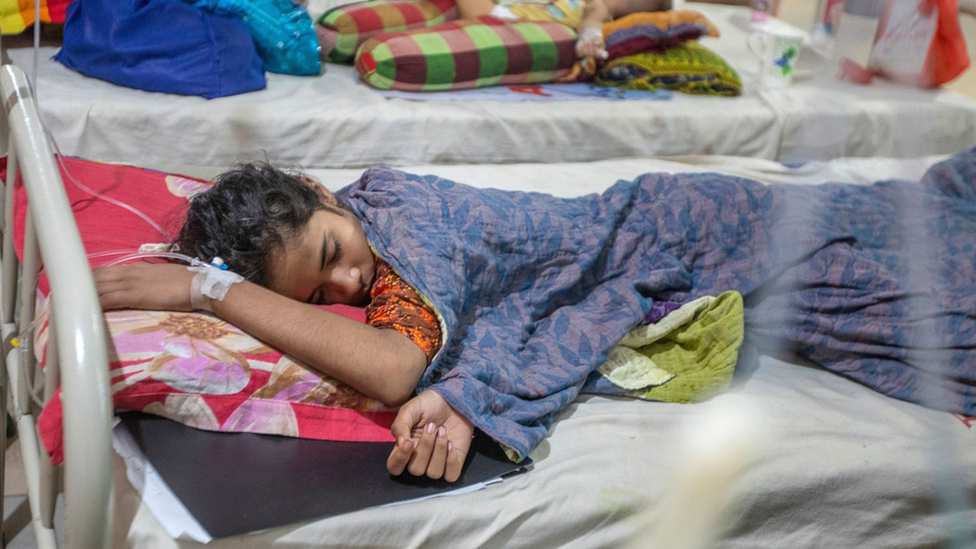How scientists are fighting climate-fuelled disease
- Published
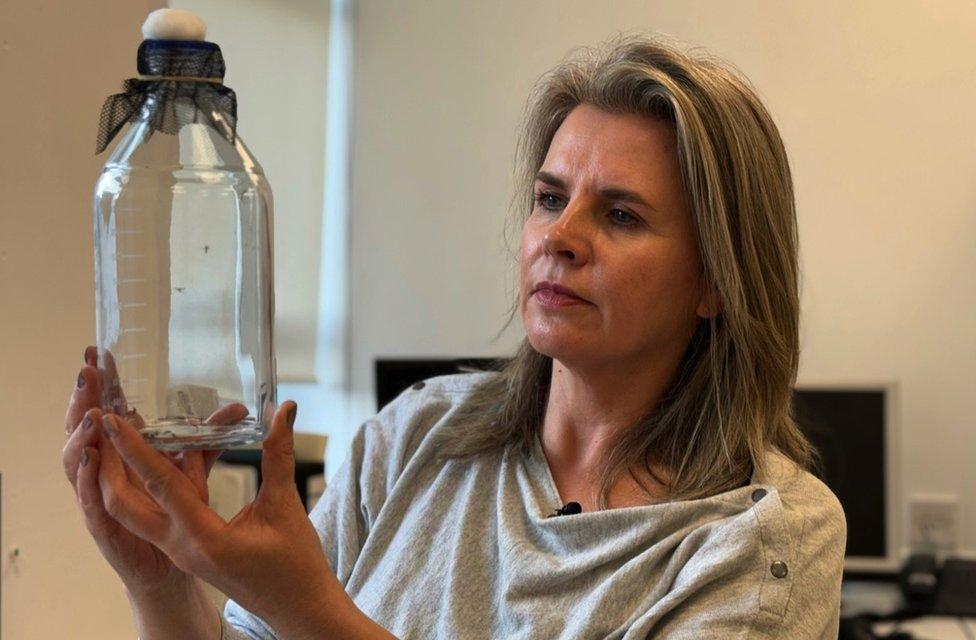
Clare Strode, a mosquito biologist at Edge Hill University, focuses her research on disease-carrying insects
"They can smell us," says Dr Clare Strode.
She is carefully carrying a mesh cage of mosquitoes across her lab in Lancashire, north-west England. To be more precise, these are Aedes aegypti, one of two species known to carry and transmit the dengue virus by biting and infecting millions of people around the world.
These particular, laboratory-resident mosquitoes are infection-free and they're trapped in a cage. Almost all of them move to sit against the wall of mesh closest to the scientist. They're hungry.
Clare is studying the insects to understand how dengue spreads around the world - and how climate change is fuelling that spread.
As leaders gather in Dubai for COP28 - the latest round of the UN's international climate talks - experts say global warming is already having a "profound effect" on global health.
Sunday is the first official "health day" of any climate COP since the conferences began back in 1995. Maria Neira, director of the World Health Organization's Department of Climate, Environment, and Health, said, "It's about time for health to take central place at the COP negotiations. Because it's urgent.

More on the COP28 climate summit

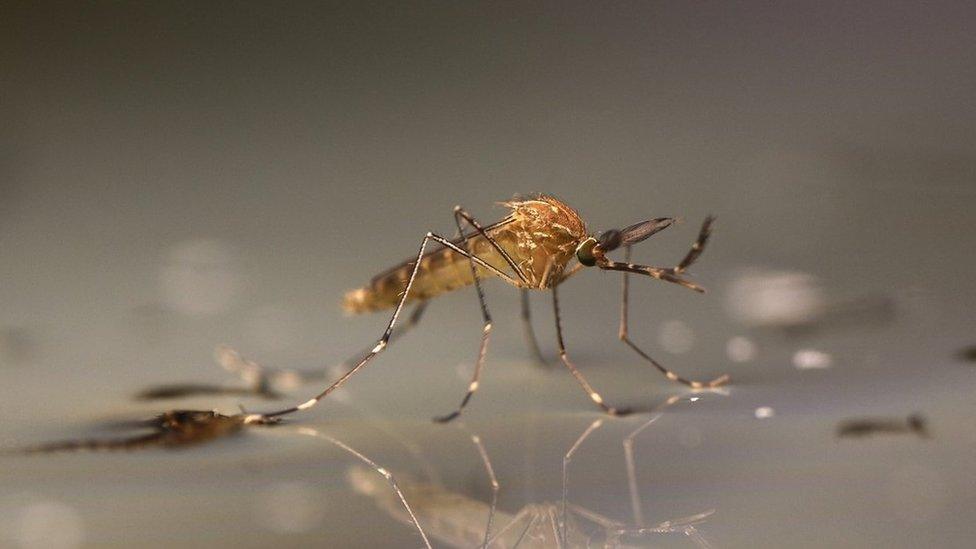
Mosquitoes breed in stagnant water, so hotter, wetter conditions are helping them thrive
Dengue is a tropical disease, but in the last few years it has arrived in Europe. Another dengue-linked mosquito, called the Asian tiger mosquito has even been caught in surveillance traps in Kent, in the UK., external
All of this is evidence of how the insects are adapting to new climates and environments. Warmer, wetter conditions linked to global warming are helping some disease-spreading mosquitoes to thrive.
Scientists though are fighting back. By combining insect surveillance with climate forecasts, they are developing ways to predict and prepare for new disease outbreaks.
Prevention is better than cure
Understanding where future outbreaks are most likely to happen could save millions of lives, scientists say. One project, funded by the Wellcome Trust, is already developing these prediction tools in 12 countries
Prof Rachel Lowe, who leads the global health resilience group at the Barcelona Supercomputer Centre in Spain explained: "We're using satellite images, collecting data from drones and weather sensors."
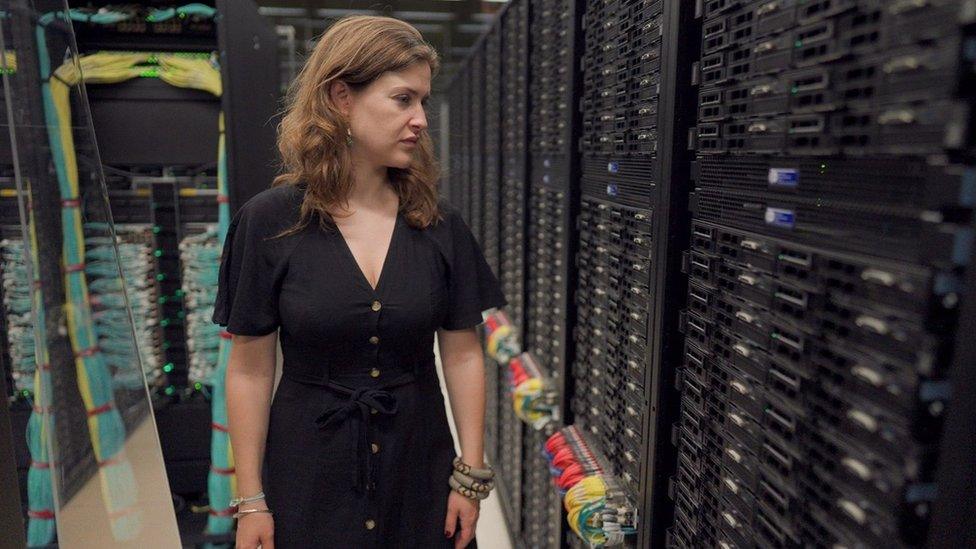
Prof Rachel Lowe is a leading health researcher whose work uses supercomputers to help predict disease outbreaks
Combining all this with information from researchers in the field, who are out there searching for mosquitoes, she said, "gives a better understanding about how changes in climate and land-use have been impacting insect-borne diseases."
By analysing weather patterns, finding the pools of stagnant water where mosquitos breed, and monitoring the other conditions that combine to fuel an outbreak, the research aims to deliver early warning systems. These will help communities prepare.
That preparation might come in the form of a public health campaign urging people to protect themselves with insect repellent, informing healthcare providers or even increasing community bin collections to minimise standing water where disease carrying mosquitos lay their eggs.
Mosquitoes are adapting
In countries where diseases like malaria and dengue are already widespread, climate change can make the high-risk seasons longer.
"What we're seeing elsewhere in the world is a warning about what is to come in the future here in the UK," says Clare. "These mosquitoes are now established in southern Europe.
"And they are such adaptable insects. They will adapt their behaviour and even their physiology to whatever scenario they live in. They've even found places to survive winters underground in colder climates."
If the current trajectory continues - without deep cuts to greenhouse gas emissions, she says, our climate will become much more conducive to supporting these mosquitoes. "They'll be able to survive our winters."
Globally, the number of cases of dengue reported to the World Health Organization has increased dramatically in the last two decades. In 2000, half a million cases were reported and by 2023, this has risen to 4.5 million reported cases.
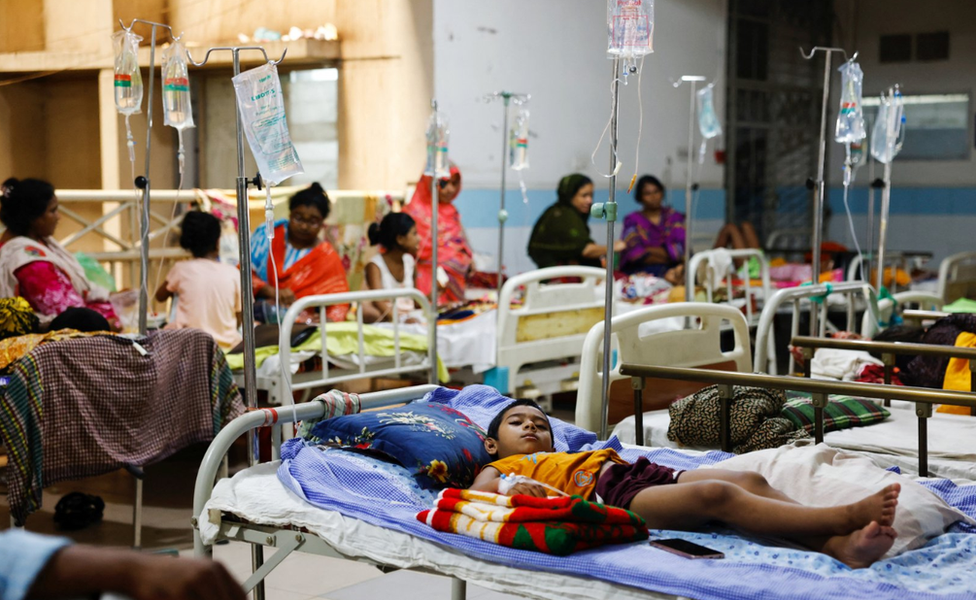
Bangladesh suffered its most severe dengue outbreak in history in 2023 - linked to hotter, wetter monsoons
It is usually a mild disease - causing a high fever for up to seven days. Most people recover. But in countries where the incidence of the disease was already high, the burden on health services is intensifying. In Bangladesh, earlier this year, nearly 1,000 people died in an outbreak that was linked to extraordinarily wet monsoons and the dirty, stagnant water in which the mosquitoes breed.
Dr Dung Phung is a researcher from the University of Queensland, who also works as a clinician in a hospital in Hanoi, Vietnam. He says the country is now seeing outbreaks in mountain regions where the disease has never been seen before.
"There is growing pressure on the healthcare system now - it's more common for multiple patients to be sharing one bed."
The clinician and researcher is involved in an early warning system called E-Dengue. It's in the first phase and aims to predict outbreaks two months in advance.. The next phase will turn it into an open software system and web app.
"It means we can mobilise the community to take preventative measures, rather than wait for a crisis," he explains.
Disease forecasting
The idea behind these early warning systems is to combine data from a variety of sources and build a picture of exactly how the climate and disease transmission are linked.
Weather stations gather accurate on the ground meteorological information, drones will help identify mosquito breeding sites and researchers gather information from local communities and health officials.
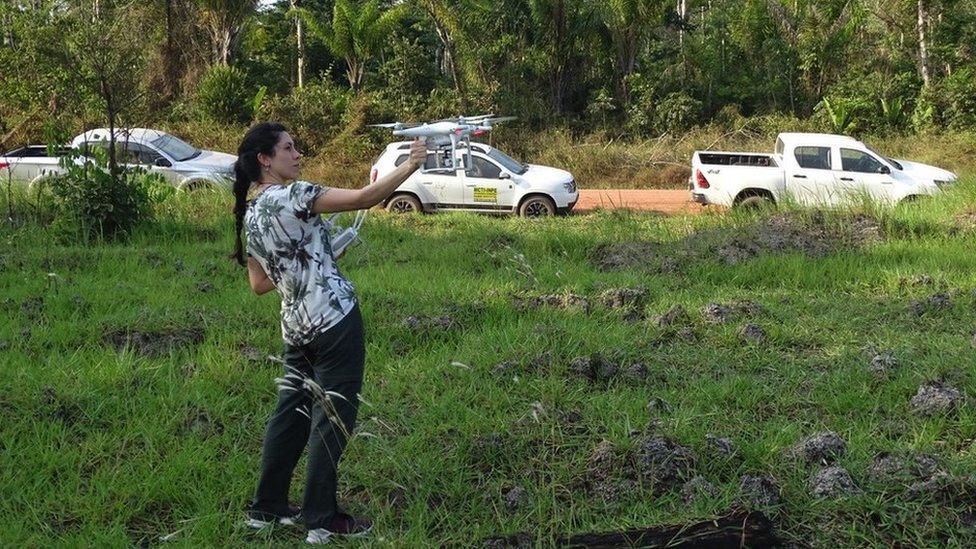
Drones and other technology are helping researchers survey the landscape and understand disease risk
A powerful supercomputer uses that data to build the predictive models. This approach is being used in a project called Harmonize. It is now being tested in a few countries, including Brazil, Columbia, Peru and the Dominican Republic and crucially its hoped it can then be adapted and rolled out anywhere and everywhere that needs it.
The goal of these predictive tools is, says Rachel, is to "prevent diseases from happening in the first place and to more effectively allocate resources to the areas most at need, so that we can make both economic savings and save lives."
In the UK, health security officials are already taking preventative measures. Mosquito traps are placed at strategic points like airports and ports to monitor whether the dengue-carrying mosquitos are entering the country.
Clare carries out some of that work - using something called DNA barcoding to identify the species of mosquito found in those traps.
"When I started, if you'd told me I'd be doing surveillance for dengue mosquitoes in the UK, I'd have been really surprised.
"But we've seen the reports coming from countries in Europe and North America, it's no longer a surprise."
Will a health day at COP make a difference?
But experts agree that, with climate change so intrinsically connected with human health, the most effective preventative measure will be to curb emissions.
"Health must be at the centre of all climate change negotiations," says Rachel. "And we must ensure that climate action is designed with both health and justice at its heart."
Clare added "Our health is directly linked to our climate and we see that with mosquito-borne diseases. The problem is only going to increase. It's not going to go away. So more attention, more funding and more focus on these types of issues is welcomed".
Related topics
- Published8 November 2022
- Published28 September 2023
